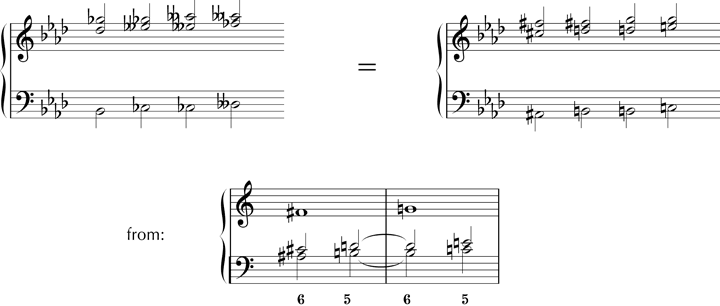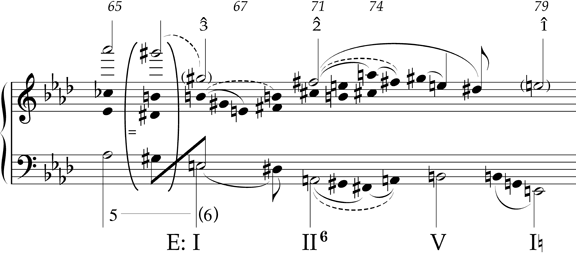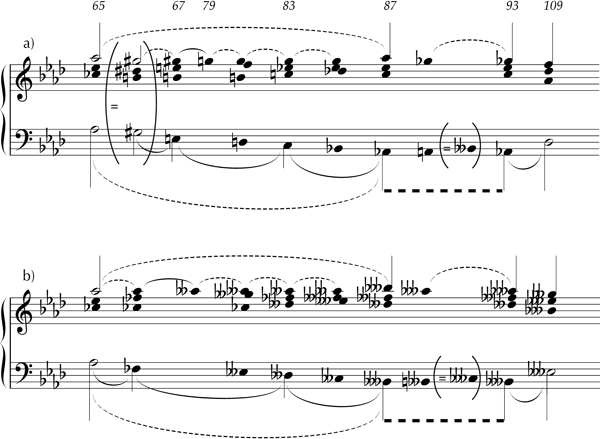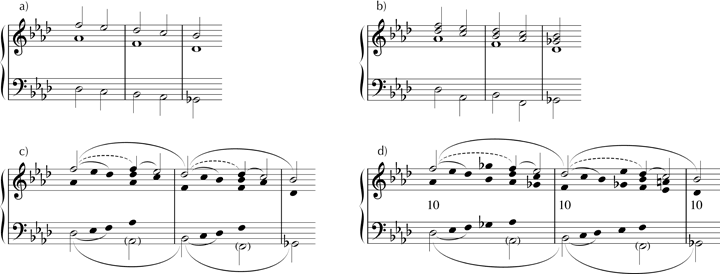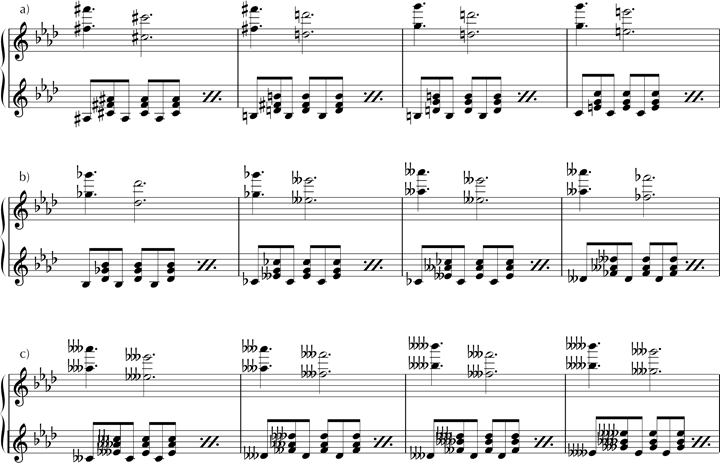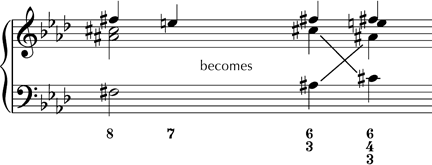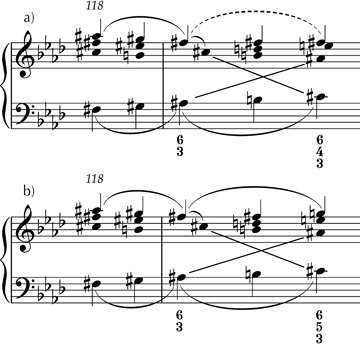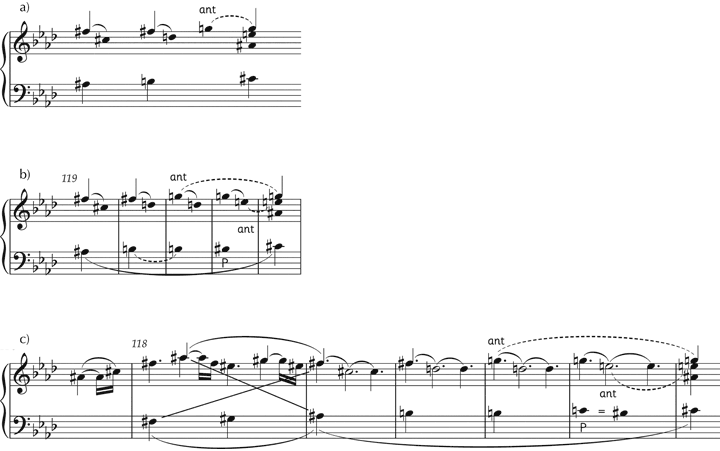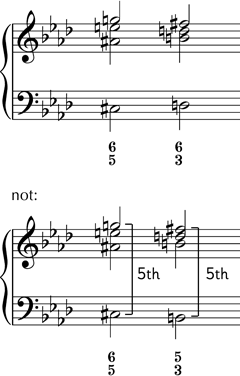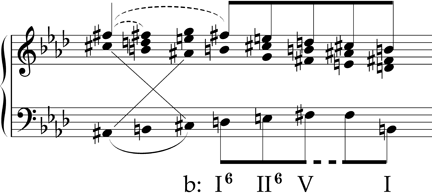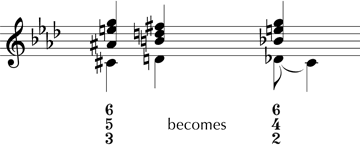E-quadruple flat: Tovey’s Whimsy
Eric Wen
This paper examines the development section of Beethoven’s Appassionata Sonata in light of Donald Francis Tovey’s whimsical remark about the appearance of an E-quadruple flat. In addition to considering Tovey’s idea, this paper examines the analysis by Heinrich Schenker, and compares the two different analysts’ interpretations. This paper concludes with a renewed examination of the passage leading into the climactic diminished-seventh chord that ends the development section, offering a detailed voice-leading analysis, as well as an idea about its programmatic meaning.
One of the most striking moments in the first movement of Beethoven’s Appassionata Sonata occurs near the end of the development at bar 123, where a succession of diminished-seventh chords over D-flat sweeps throughout the entire range of the keyboard. The passage leading up to this climactic diminished-seventh chord conveys a dramatic tension that is extraordinary, even for Beethoven. Furthermore, it contains a surprising enharmonic change. After commencing with a statement of the secondary theme in the key of G-flat major in bar 117, the music is suddenly notated enharmonically two bars later as F-sharp major. Although the key of F-sharp major has just as many sharps as the key of G-flat major has flats, the reason for Beethoven’s enharmonic change becomes clear in bar 120, with the appearance of a B-minor chord. As Example 1 shows, retaining the context of G-flat major would have led to the cumbersome notation of a C-flat minor chord.
Example 1: The notation of bars 118–120 without enharmonic change
But as ungainly as C-flat minor in bar 120 may seem, the spelling becomes even more unsightly if we were to continue further without Beethoven's enharmonic change. Example 2 shows how these bars would have led, without the enharmonic change, to a D-double flat major chord in bar 122. In any case, no matter what notation is used, bars 119–122 articulate a non-diatonic progression that rises up a diminished third in the bass. Example 3 shows the contrapuntal origin of these bars, alternating 6/3 and 5/3 chords. This contrapuntal progression can be understood to derive from three-part combined species with two voices in fourth species, but since the bass voice moves up a diminished third from A-sharp to C-natural, it cannot belong to any diatonic key.
Example 2: The notation of bars 119–122 without enharmonic change
Example 3: Chordal reduction of bars 119–122 and its contrapuntal origin
Another striking enharmonic change occurs earlier in the Appassionata, at the beginning of the development section. Although it is usual for expositions in sonata-form movements in minor to lead from I to III, in this movement Beethoven alters the usual mediant harmony of A-flat major to A-flat minor. At the start of the development in bar 65, Beethoven enharmonically rewrites the A-flat minor harmony as G-sharp minor, and, through a 5-6 contrapuntal motion, moves to E major in bar 67. A tonal reduction of the E-major statement of the opening theme that starts the development section is given in Example 4. At the end of this E-major statement of the opening theme Beethoven employs modal mixture yet again, closing the theme in E minor.
Example 4: E major statement of the opening theme at the start of the development
Following the E minor cadence, the music unleashes into a passionately articulated sequential motion down in major thirds. Example 5a presents an outline of the progression as Beethoven wrote it, showing a motion down three major thirds from the A-flat minor harmony that ends the exposition. Although this A-flat minor is enharmonically altered to G-sharp minor at the start of the development in bar 65, the beginning and end points of this progression represent an elaboration of the same note.
Example 5: Progression in descending major thirds at the start of the development, a) Beethoven’s notation with enharmonic change, b) notation without enharmonic change
Example 5b notates the progression down in major thirds without the initial enharmonic change of A-flat to G-sharp minor. Without the enharmonic rewriting, A-flat would have descended down an augmented seventh to B-double flat. Although this is the “real” spelling of what happens, since the beginning and end points of this progression “sound like” the same note, we perceive the net result of this motion down three equidistant intervals of a major third as a prolongation of A-flat. In a tonal system in fact, the only way this progression makes sense is reflected by the notation that Beethoven used, where G-sharp and A-flat are enharmonically equivalent.
Although the development begins in A-flat minor, it is altered back to A-flat major, following the progression down in major thirds. In bar 89 the lowered seventh G-flat appears, and the bass rises up to A-natural. The resultant diminished-seventh chord creates a feeling of anxiety, uncertain as to where it will lead, but this ominous quality is soon dissipated as the chord is transformed into a dominant seventh. The A-natural ultimately behaves as B-double flat, the lowered 6 scale degree in D-flat, and serves as an upper neighbor to A-flat in the bass. This A-flat dominant-seventh chord beginning in bar 91 leads into a restatement of the second theme in D-flat in bar 109.
The arrival on the second theme in D-flat major in bar 109 is clearly an important event as it is the first time a key area becomes stabilized in the development. Furthermore, the choice of the key of D-flat is significant. As numerous writers have pointed out, the note D-flat as the upper neighbor of C has a pervasive motivic significance throughout the Appassionata Sonata as a whole.[1]
Apart from its transposition into D-flat major, the return of the second theme appears exactly as it did in the exposition. Instead of closing in D-flat, however, it makes a deceptive cadence in B-flat minor in bar 113. At this point another statement of this theme occurs, but now in B-flat minor. This, too, leads to a deceptive cadence, resulting in yet a third appearance of the second theme in G-flat major at bar 117. Example 6 presents an outline of this tonal motion that articulates three successive appearances of the second theme rising up in sixths. Example 7 shows how this pattern of rising sixths derives from a descending 5-6 sequential pattern in descending thirds.
Example 6: The sequential appearance of the “second” theme in the development
Example 7: The contrapuntal origin of the sequential appearance of the “second” theme
Beethoven purposely chooses the path going up a sixth, rather than down in thirds, in order to create a rising line in the bass. The bass motion over bars 109–119 from D-flat to b-flat traverses an ascending 13th, i.e. an octave and a sixth. In fact, this ascending bass motion could even have carried on further, as shown in Example 8.
Example 8: Possible continuation of bars 118ff
But instead of continuing as in Example 8, Beethoven breaks off the pattern in bar 119. This is the place we encountered at the beginning of this paper, where G-flat becomes enharmonically rewritten as F-sharp major. We have already seen how these bars express an ascending 6-5 sequence leading up a diminished third (see Example 3). In bar 123 this contrapuntal pattern is itself broken by the arrival of a diminished-seventh chord over D-flat marked fortissimo.
Having gone through the events of the development so far, it is now an opportune moment to discuss the whimsical notion of E-quadruple flat, as indicated in the title of this paper. It was Donald Francis Tovey, the most important British analyst of the first half of the 20th century, who first suggested the appearance of this outlandish note. It arises in his essay on the Appassionata in his Companion to the Beethoven Pianoforte Sonatas.[2] The publisher of this work was the Associated Board of the Royal Schools of Music, an institution primarily serving Great Britain and the British Commonwealth that assesses musical achievement through a series of examination in eight levels, known as “grades.” Tovey’s Companion was intended as a supplement to the Associated Board's three-volume edition of the complete 32 Beethoven piano sonatas that he prepared in collaboration with Harold Craxton.[3] The Associated Board continues to serve practical musicians, and aims their publications at students and serious amateurs. But many encountering E-quadruple flat would no doubt have been totally perplexed by Tovey’s fanciful note.
In the midst of a descriptive commentary, Tovey writes:
The bass [in bar 120] is on C-flat = B-natural. The next two bars bring it to C. The key of C-flat minor is written as B minor; once more we are in an enharmonic circle – in the same direction as the previous one – so we will not enquire into the relation of E-quadruple flat to the home dominant, but will attend to serious matters.[4]
Tovey’s observation that the B minor chord in bar 120 really represents C-flat minor is an idea we have already encountered (see Example 1). However, his reference to E-quadruple flat appears out of nowhere. There is no reference to where it occurs in the music. And, no sooner than he conjures up this whimsical aside, he shrugs it off with a characteristically British nonchalance.
The key to the meaning of Tovey’s remark lies in the phrase “once more we are in an enharmonic circle – in the same direction as the previous one.” What he is saying is that the enharmonic change that results in writing C-flat as B-natural is the second of two enharmonic changes. The first enharmonic change that Tovey refers to is the one that appears at the very beginning of the development when the A-flat minor that closes the exposition is enharmonically rewritten as G-sharp minor. In other words, if we notated the motion down in major thirds over bars 65–87 literally, we would have ended up on a B-triple flat, instead of A-flat, chord in bar 87, as shown in Example 5b. We would then have had to understand the appearance of the second theme in bar 109 as being in E-triple flat, instead of D-flat. If we carried forth this notation, the motion up in sixths from D-flat through B-flat to G-flat should have been written as E-triple flat through C-double flat to A-triple flat.
Example 9 isolates the bass line motion over bars 109–123. As we can see in Example 9a, Beethoven’s original notation, there is a two-octave ascent in the bass from D-flat to d-flat2. In order to retain octave equivalency, however, two enharmonic changes (shown within the boxes) were necessary. If these enharmonic changes weren't made, this passage would be notated as in Example 9b.
Example 9: The two-octave ascent in the bass from bar 109 to 123, a) Beethoven’s notation with enharmonic changes, b) notation without enharmonic changes
Example 10 presents three different notations of bars 119–122. Example 10a reproduces Beethoven’s original notation. Example 10b rewrites the passage retaining the G-flat notation from bar 118 onwards, and Example 10c shows the notation without either of the two enharmonic changes. In the last example, bar 122 culminates on the E-quadruple flat chord that Tovey predicted – not a pretty sight!
Example 10: Three enharmonically equivalent notations of bars 119–122, a) Beethoven’s notation of the passage after making two enharmonic changes, b) notation of the passage after making one enharmonic change, c) notation of the passage without making any enharmonic changes
Despite Tovey’s fanciful allusion to E-quadruple flat, the specific spellings of the notes in this passage are ultimately unimportant. As he says, we must “attend to serious matters.” In his unfinished book on Beethoven[5], published posthumously in 1944, Tovey examined the Appassionata once again, and described the passage starting from the D-flat major statement of the second theme as follows:
The calm theme, having thus entered with enharmonic impressiveness in D flat, should after four bars begin to repeat itself in the upper octave. Instead of this, the bass continues rising. This forces the theme in a crescendo through a series of keys which it is not worth specifying. The point is: first, that the bass rises for two octaves, and that at the top of its climb articulate music ceases…. Melody disappears and harmony becomes ambiguous…. Rhythm itself would disappear but for the fact that, so long as we remain conscious, we cannot get rid of time. In the present passage, the first sign of a return to articulate speech is in an ominous rhythmic figure (bar 130), and the diminished seventh resolves into the home dominant, and so leads us to the recapitulation.[6]
For Tovey, the diminished-seventh chord at bar 123 represents a moment of total upheaval, what he describes as a “passion [that] is beyond articulate utterance.”[7] Furthermore, the events that occur en route to this point, whether notated as C-natural or E-quadruple flat, are incidental. Tovey may have evoked an enharmonic monstrosity, but its notational correctness doesn't impinge upon what happens in the piece. Only at the moment in bar 132 when the bass of the diminished-seventh chord on D-flat resolves down to C is the “inarticulate” climax resolved. At the appearance of the dominant seventh of F minor tonal clarity is restored.
Unlike Tovey, Heinrich Schenker, the British theorist’s Austrian contemporary regards the arrival on the diminished-seventh chord over D-flat as the focal point in the development. For Schenker, the diminished-seventh chord represents the dominant-seventh of F minor with D-flat in the bass as an upper-neighbor decoration of C. Because he regards the diminished-seventh chord as a concrete entity, he proposes the inspired idea that the bass of this chord connects back to the D-flat statement of the second theme in bar 109.[8]
In Schenker’s view, the D-flat statement of the second theme serves to stabilize the most important motivic idea in the piece. Its ultimate descent back to C at the recapitulation thus represents a large-scale expansion of the neighbor-note figure D-flat – C. Example 11 presents the successive stages of the motion from the mediant that ends the exposition to the dominant C major in bar 132, based on Schenker’s idea.
Example 11: The tonal structure of the development (after Schenker)
As shown in level b of Example 11, the motion to D-flat avoids the direct chromatic succession of E-flat (over III) to E-natural (over V), but results in parallel fifths between the outer voices. In level c, these parallels are avoided by a motion into an inner voice through the lowered seventh G-flat that also transforms the mediant harmony into the applied dominant seventh of D-flat major. Following the dramatic rise up two octaves in the bass, the huge fall back into the low bass register offers further support for Schenker’s reading. Example 12 highlights the registral connection of the low D-flats.
Example 12: The registral connection of D-flat in the bass
The two interpretations by Tovey and Schenker would appear to be working at cross purposes. Tovey’s descriptive account attempts to capture the emotional impact of the arrival of the recapitulation. Schenker, on the other hand, stresses the logic of the development's construction by showing how every element fits into the whole. In Schenker’s foreground graphs of the development, he even accounts for the B-flat minor and G-flat statements of the second theme as intermediate steps within the large-scale progression.[9]
The arrival on the diminished-seventh chord over D-flat in bar 123 is undoubtedly the climactic moment in the development. Beethoven remains on this chord for nine bars, arpeggiating it across nearly five octaves on the keyboard. Furthermore, his direction sempre pedal results in an almost chaotic wash of sound. At bar 132, D-flat descends down to C, and the diminished-seventh chord becomes the dominant-seventh that leads us into the return of the opening theme at the recapitulation.
The arrival on the dominant-seventh chord of F minor is the goal point for both Tovey and Schenker. For Tovey, the tonal events leading up to the dominant are part of an impassioned dramatic gesture that embraces far-fetched enharmonic progressions that cannot be taken literally. For Schenker, it marks the fulfillment of the all-important motivic neighbor-note figure, D-flat – C. But there is something more. For the sake of notational convenience, let’s consider the passage from bars 118 onwards in the key of F-sharp, rather than in G-flat as Beethoven initially wrote it.
As the final stage of a sequence moving in descending thirds shown in Examples 6 and 7, the F-sharp (= G-flat) major appearance of the second theme is the last unambiguous tonal event before the arrival on the diminished-seventh chord at bar 123. If we respell the diminished-seventh chord with C-sharp instead of D-flat in the bass and A-sharp instead of B-flat in the inner voice, the tonal connection between the F-sharp major harmony expanded over bars 118-119 and the dimininished-seventh chord expanded over bars 123-131 becomes clear. As shown in Example 13, the F-sharp major harmony is transformed into an active leading-tone seventh chord through the addition of the seventh E-natural.
Example 13: The addition of a 7th to an F-sharp major chord
Level a of Example 14 shows how a passing B-minor chord connects the F-sharp 6/3 chord to the F-sharp dominant-seventh chord in 4/3 position. Level b shows how the F-sharp 4/3 dominant-seventh chord becomes altered into an A-sharp diminished-seventh chord through the change of F-sharp to G-natural. Functionally, the F-sharp dominant-seventh 4/3 chord and A-sharp diminished-seventh 6/5 chord are similar; both of them have an urge to resolve to B minor, a harmony that never actually materializes.
Example 14: The alteration of a dominant 3/4 into a diminished-seventh 5/6 chord
In making a tonal connection from the F-sharp 6/3 chord in bar 119 and the A-sharp diminished-seventh chord in bar 123, we are now in a position to understand the true significance of the progression that connects them. Although the chordal succession over bars 119–122 can be understood as a non-diatonic 6–5 contrapuntal sequence (see Example 3), its tonal meaning is presented in Example 15. As shown in level a, the G-natural in the top voice that anticipates the seventh of the A-sharp diminished-seventh first appears in bar 121 through a 5–6 contrapuntal motion over the passing B-minor chord in bar 120. Level b shows how the harmony of bar 122 is created out of melodic figuration: the E-natural in the middle voice is an anticipation, and the bass note C-natural is a chromatic passing note between B and C-sharp. Although Beethoven writes the bass of bar 122 as C-natural in the actual music, functionally, it behaves like a B-sharp, leading from B-natural to C-sharp.[10]
Example 15: The tonal progression over bars 119–123
Example 16 shows how the arrival on a 6/5 position of an A-sharp diminished-seventh chord with C-sharp in the bass must resolve to a B-minor chord in 6/3 position with D as its bass note. The bass motion C-sharp – D-natural is a consequence of the proper resolution for this form of the diminished-seventh chord. The proper spelling of a diminished-seventh chord in 6/5 position over C-sharp in the bass contains the notes A-sharp, E-natural and G-natural. The top voice G must descend to F-sharp, because it is the seventh of the chord. The inner voice A-sharp, as leading-tone, must ascend to B-natural. Since the top voice G-natural descends to F-sharp, the bass C-sharp must ascend to D, to avoid the voice-leading error of having a diminished fifth (G over C-sharp) move in parallel motion to a perfect fifth (F-sharp over B).
Example 16: The correct resolution of a diminished-seventh chord in 5/6 position
What makes this passage so wonderful is, of course, the silent enharmonic change that Beethoven makes. Instead of leading up to a B-minor 6/3 chord, and eventually cadencing in B minor, as might have occurred in Example 17, Beethoven alters the diminished-seventh chord over bars 123-131 from 6/5 position to 4/2 position. As a result, the C-sharp in the bass, written as D-flat, descends most surprisingly down a semitone to C-natural in bar 132, as shown in Example 18.
Example 17: A possible continuation of the diminished-seventh chord
Example 18: The altered meaning of the diminished-seventh chord in bars 123ff
In pieces in the minor mode, flat 6, D-flat in F minor, has a natural tendency to descend to 5, C. Although this is what happens in bar 132 of this sonata, we have seen in our analytic discussion that Beethoven infuses the bass note D-flat in the diminished-seventh chord in bar 123 with the urge to continue rising upwards to D-natural. Furthermore, the diminished-seventh chord over D-flat is the culmination of the sweeping two-octave ascent in the bass from D-flat to d-flat1 over bars 109–123. This rising line establishes a force of energy that drives the impetus upwards. At the top of this ascent, the bass of the diminished-seventh chord reverses its direction and falls down to C-natural. The attempt to move up to D-natural is ultimately frustrated, as the natural tendency of 6 to fall to 5 in the minor mode cannot be denied. It is as if the progression’s desire to break free of its inevitable destiny is renounced. At the arrival of C-natural in the bass at bar 132, the pedal marking is lifted and tonal clarity is restored. This is the crucial moment in the piece, and it is here that we wake up painfully back in the stark reality of F minor. With this feeling of heightened tragedy, the dark and ominous opening theme returns, and we arrive at the recapitulation.
In our examination of the development of the Appassionata we have seen how two deeply perceptive theorists respond differently to a remarkable tonal passage. Tovey conveys his emotional response to this work by describing the arrival on the dominant C as the moment in which unbridled passion becomes reined in and returns, in his words, to “articulate speech.” Schenker, on the other hand, views this same moment as confirmation of the supreme logic of Beethoven’s overall structure through a large-scale expansion of the pervasive neighbor-note idea. In this paper, I have intended to reconcile the different vantage points by these two influential analysts. By examining the details of the foreground voice-leading, I hope also to have added a deeper insight into our understanding of Beethoven’s masterpiece.
Notes
The most exhaustive study of the neighbor-note figure, D-flat – C, appears in Heinrich Schenker 2005. Rudolf Réti (1967) also explores this neighbor-note “cell” throughout the sonata. Other discussions of this motivic figure in the Appassionata can be found in William Kinderman 1995, Barry Cooper 2000 and Charles Rosen 2002. | |
Tovey 1931. | |
Beethoven: Complete Pianoforte Sonatas, vol.3, edited by Harold Craxton and annotated by Donald Francis Tovey, London: The Associated Board of the Royal Schools of Music 1931. | |
Tovey 1931, 180. | |
Tovey 1944. | |
Tovey ibid., 44. | |
Tovey 1931, 181. | |
Schenker 2005, 46. | |
Schenker’s interpretation of the tonal meaning of the B-flat and G-flat harmonies is outlined in levels b and c of Figure 5, in Schenker 2005. | |
Curiously, in Schenker’s final analytic interpretation of this movement, he interprets this “C-major” chord in bar 122 incorrectly as the structural dominant in Fig. 154/4 (1979). Although this chord is spelled as a C-major triad in root position, this harmony sounds very unstable, and is actually created out of anticipations and a chromatic passing tone in the bass. As shown in my Example 15, what appears to be a root-position C-major triad is actually the most unstable sonority of the entire passage. Schenker is correct in viewing a large-scale expansion of the motive D-flat – C in the development, but it is the bass note C in bar 132, not in bar 122, that articulates the structural arrival on V. Schenker’s earlier reading from Der Tonwille, where he views the arrival on the dominant at bar 132, is thus more convincing than the later one in Der freie Satz. |
References
Cooper, Barry (2000), Beethoven, Oxford: Oxford University Press.
Kinderman, William (1995), Beethoven, Oxford: Oxford University Press.
Réti, Rudolf (1967), Thematic Patterns in Sonatas of Beethoven, London: Faber and Faber.
Rosen, Charles (2002), Beethoven’s Piano Sonatas: A Short Companion, New Haven: Yale University Press.
Schenker, Heinrich (2005), “Beethoven’s Sonata in F minor, Op. 57,” in: Der Tonwille, translated by Robert Snarrenberg and edited by William Drabkin, Oxford: Oxford University Press.
––– (1979), Free Composition, translated and edited by Ernst Oster, New York: Longman Inc.
Tovey, Donald Francis (1931), A Companion to Beethoven’s Pianoforte, London: The Associated Board of the Royal Schools of Music.
––– (1944), Beethoven, Oxford: Oxford University Press.
Dieser Text erscheint im Open Access und ist lizenziert unter einer Creative Commons Namensnennung 4.0 International Lizenz.
This is an open access article licensed under a Creative Commons Attribution 4.0 International License.


